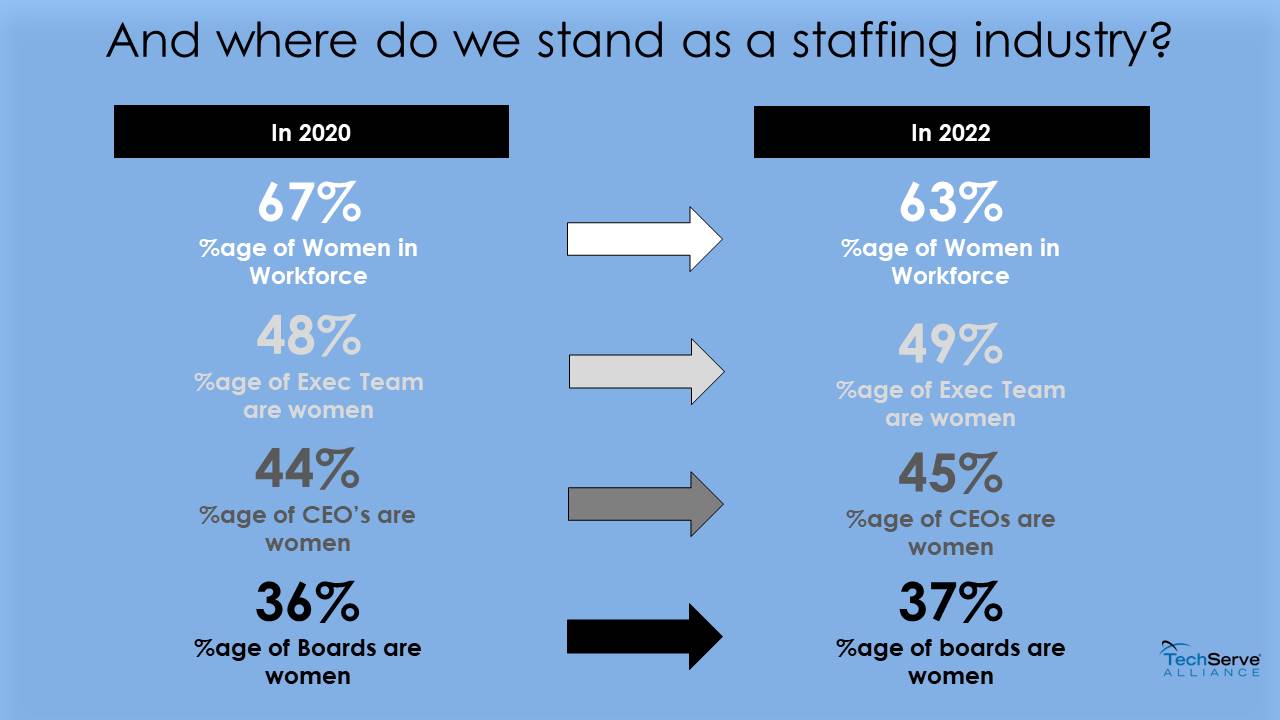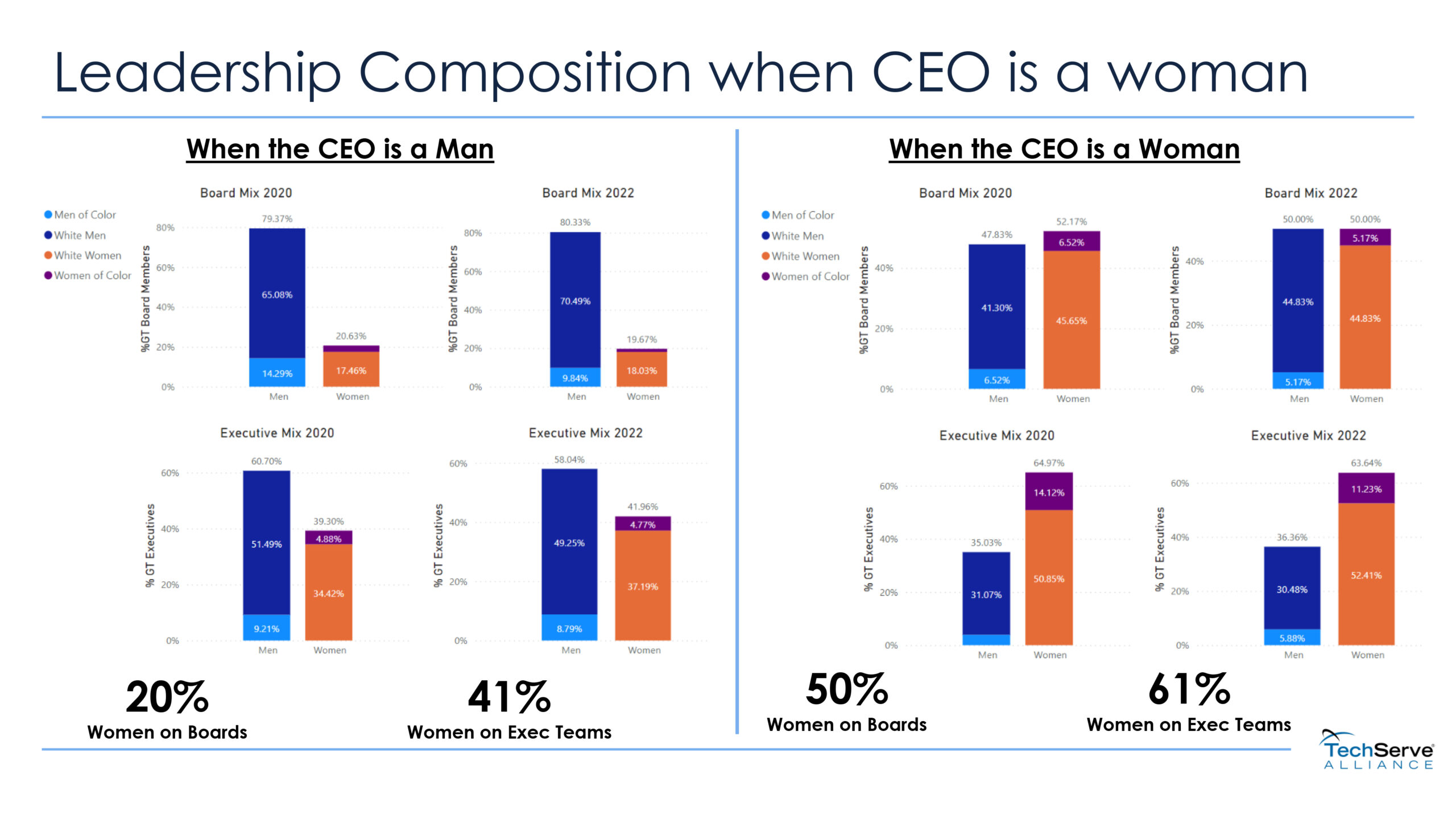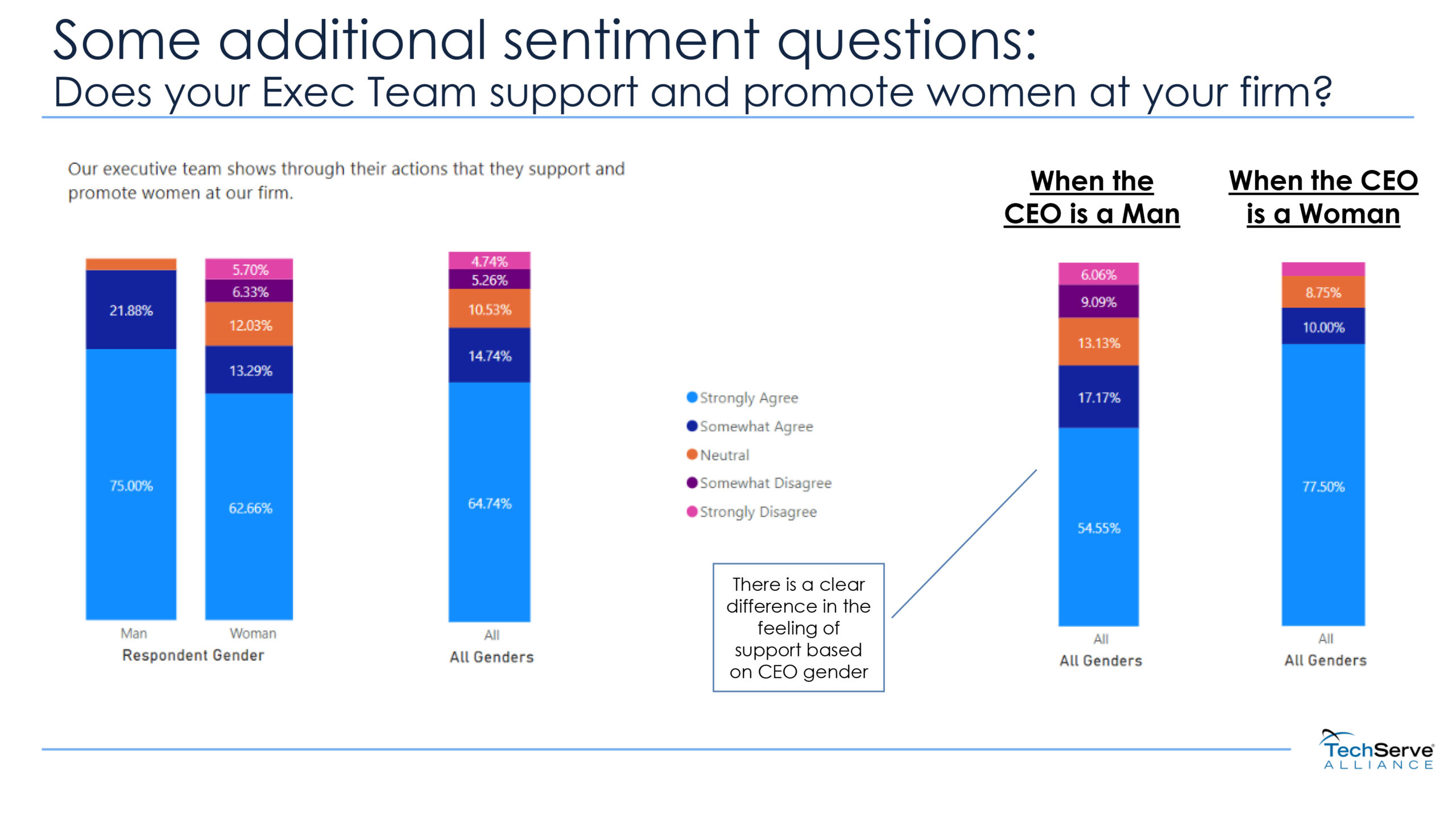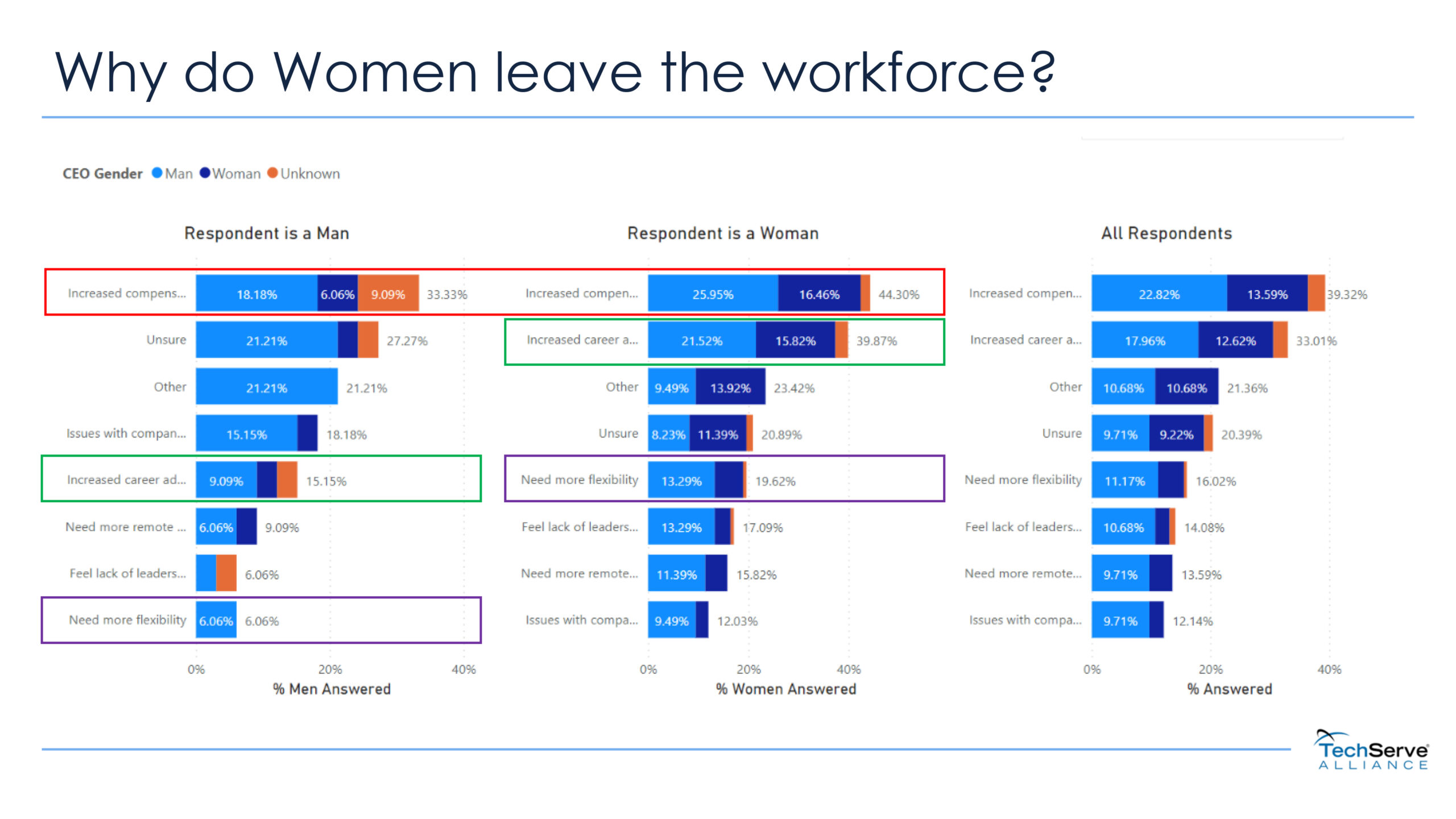
Improvements Seen in Gender Equity Progress in the Staffing Industry
The staffing industry has a pivotal role to play in the advancement of gender equity. “We affect the lives of nearly 10 million people every year on short and long-term assignments,” Kip Wright points out. “The impact this industry can have on diversity, equity and inclusion is profound.” It stands to reason, then, that equity within the staffing industry itself is an indicator of progress.
Wright is CEO of INSPYR Solutions, and serves as a board member for Women Business Collaborative (WBC). WBC’s mission is to achieve equal position, pay, and power for all business women. The organization recently conducted its second survey focused on gender equity in the staffing industry, in partnership with Staffing Industry Analysts (SIA), the American Staffing association (ASA), and the National Association of Personnel Services (NAPS), and TechServe Alliance.
TechServe hosted a webinar to present and discuss the results of that survey. The webinar panel was moderated by Wright, and included Denise Dettingmeijer, CFO, North America with Randstad, Sunny Ackerman, President, Americas with SThree, and Threase Baker, President of AbbTech and Chair of ASA.
Data shows modest progress
The statistical validity of the results is robust, with nearly 600 participants industry-wide. Some highlights from the report:

- Percentage of the workforce who are women
63% (down from 67% in 2020) - Percentage of the executive team who are women
49% (up from 48% in 2020) - Percentage of CEOs who are women
45% (up from 44% in 2020) - Percentage of board members who are women
37% (up from 36% in 2020)
Within the overall numbers, there’s a great deal of room for variance. Dettingmeijer, for example, points out that in large global firms like Randstad, the numbers tend to be lower overall. These global companies represented 20% of the survey respondents. On the other hand, Ackerman notes that in the case of companies headquartered in Europe, like SThree, the numbers trend higher due to legislative requirements for gender parity.
While the survey results show a small increase in the number of women in executive roles, Wright points out that there are nuances even within those statistics. “There’s a point that is so relevant to many of us, and that’s getting women into P&L and operational roles. Those metrics may be somewhat misleading because they’re in roles that might be in HR or Marketing. Not to say those aren’t important, but the balance across all the executive roles is important.”
Digging Deeper
There were some intriguing differences when the results were analyzed looking separately at companies led by a woman CEO versus those with a CEO who is a man.

Where the company CEO is a woman …
- The board’s gender mix is evenly split (compared to a board comprised of 80% men where the CEO is a man)
- 63% of the executive team are women (compared to about 40% women where the CEO is a man)
When asked if the executive team shows through their actions that they support and promote women, the results showed that …
- 77.5% strongly agreed, and an additional 10% somewhat agreed, where the CEO is a woman
- 54.5% strongly agreed, and 17% somewhat agreed, where the CEO is a man
The panel agreed that a company with women in executive roles is likely better positioned to advance the careers of other women. “Women in upper management positions may also motivate women throughout the company workforce to be inspired. Kind of ‘See it, be it,’” Ackerman says. “These companies are better able to lean in and create programs around that to bring awareness to the organization.”
Gender in company leadership wasn’t the only source of variance in the results. Analyzing the results of the survey presented the opportunity to look at responses from men and women separately. This surfaced some intriguing differences in several sentiment questions.

In response to the question about whether the executive team supports and promotes women …
- 75% of men said, ‘Strongly agree’, and an additional 21% answered ‘Somewhat agree’
- Only 62.6% of women said, ‘Strongly agree’, with an additional 13.3% saying ‘Somewhat agree’

When asked why women leave the workforce, ‘Increased Compensation’ was the top answer for all respondents. However …
- 21.5% of women answered, ‘Career advancement’ (compared to only 9% of men)
- Over 13% of women answered, ‘Need more flexibility’ (compared to only 6% of men)
This final disparity is significant, and Dettingmeijer believes that this is a function of societal expectations. “Generally, in our world today, women are primary caregivers, whether it be children, elderly parents, volunteering in the community, taking care of a house, whatever that is.” Dettingmeijer says this creates a difference in the ability of women to look after responsibilities in their work and outside their work, compared to the ability of men to do the same. “I’ve always preached that work-life blend is more realistic than work-life balance. If you have to balance everything and have sitters for kids and people taking care of homes and visiting your elderly parents, it’s a constant fight for that balance.”
Next steps for progress
There is a lot of distance still to be traveled on the road to true gender equity. While the survey results indicate modest gains in some areas, the staffing industry – and the business world as a whole – clearly has much work yet to do.
Actions to create progress can begin with a shift in thinking. Dettingmeijer attributes some of Randstad’s progress to this kind of shift. “We decided not to call it unconscious bias, which everybody has. You can’t do anything about it because you’re human. We flipped it, and we call it conscious inclusion. How do you consciously include people in what you’re doing and how you’re working?”
The members of the panel also discussed the importance of mentorship, and providing opportunities for women to connect and learn from each other, and from allies. “It doesn’t have to be in a formal mentorship or sponsorship program,” Ackerman says, “but taking time and making space for individuals within your organization. It’s important to create a sense of support. I feel like I have an obligation to other women coming into the organization, and other women that I work with. I think all of us should, both women and men.”
Connections inside and outside the organization also provide opportunities for support and growth. “Conferences and internal events can be an easy way of connecting with like-minded women, and learning more and taking action,” Ackerman points out.
There are specific, tactical actions that can be implemented by leaders who want to accelerate progress. As an example, Dettingmeijer points to changes that Randstad put in place. “Pushing for a slate of diverse candidates moved our metrics. Every job that we post has to have a diverse slate. After that started to show progress, we then said, ‘Who do you hire from the diverse slate?’ So, it’s not only having the slates, but looking at how the hires are made.”
Awareness is the first step
One fundamental first step, the panel members agreed, is the awareness created by the survey results. “Awareness creates action,” Baker says. “We just shared our experiences and our thoughts on this survey with 350 people who are going to go back to their organizations and say, ‘Hey, I just sat on this webinar, and this is what I learned, these are the questions I have, and these are my ideas and suggestions.’ That’s where the actions start. One person can’t do everything, but everyone can do something.”
One thing you can do – especially if you missed the opportunity to see it live – is to watch the webinar. There was a lot more discussion amongst the panel members, and the entire presentation was recorded. Click here to watch the webinar and gain even more insight.
